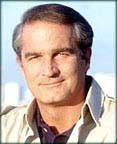|
The
Western Wildfires
Dispatch
by Bill Redeker
ABC News Correspondent, Denver
|

|
A typical day can
begin at 3:00 a.m. when we begin positioning ourselves for Good Morning
America. Systems (lights, cameras, audio lines, and IFB circuits) need
to be fully functional one hour before air time. Since New York is two
hours ahead of the Intermountain West, that means we have to be "checked
out" beginning at 4 a.m. for a 5 a.m. (local) broadcast. It doesn't
seem to matter to our editors that many times, it's still dark out..they
say they want the "immediate feel" live two-way communication
brings to the broadcast.
And it's not just the correspondent who gets up at these pre-dawn hours.
A typical "live" crew requires a producer who coordinates
the logistics, a cameraman, sound technician, and satellite truck operator.
Sometimes, a video tape editor is required. And if the budget is no
object (when's the last time you heard that?) a lighting crew and director
can be added.
The day continues with Mid West and Western updates for those time zones.
Finally, by 10 a.m. (9 a.m. West Coast) we're "goodnighted"
(cleared) and ready to work on World News Tonight. The rest of the day
is spent coordinating coverage and, as a correspondent, personally getting
out in the field to at least one location before returning to write
and edit the story.
Again, since we operate on East Coast time, the story has to be written,
approved by New York based editors (including Peter Jennings), recorded,
edited against the pictures, and transmitted no later than a few minutes
before air time (6:30 p.m., New York...4:30 p.m. Mountain).
Once we've assembled the pictures and interviews, I spend about an hour
writing the script. In a fully functioning satellite truck, I have at
my disposal access to wire service reports, major newspapers, our affiliated
TV station material (which can be critical), our editors and reporters
in New York and elsewhere.
It's not always that easy. Last week, while covering the Hayman fire,
nothing worked. So, I sat in the back of a truck and wrote the story
long hand and dictated my copy to editors in New York. This probably
consumed another hour worth of work. I also had no access to screening
equipment. I was "walked through" what pictures and interviews
had already been fed to our people in New York from three different
locations. Usually a "catcher" (producer) in New York provides
that information.
Somehow, at the end of the broadcast day, it all came together and looked
pretty good. I credit good photographers and good editors--and we have
some of the best--and heads up work by our affiliated stations.
Still, the work day is not over. Our dot-com service always wants a
print version of the day's events and they are not happy with a simple
re-write. A new takeout of up to a thousand words takes another hour.
Meanwhile, our camera crew is back taking pictures of a townhall meeting
for use in the next day's morning news story. The overnight news broadcast
also needs to be fed.. usually an on camera de-brief that will be supplemented
with pictures already in New York. Finally, Nightline. Usually because
of the long hours, that broadcast assigns their own coverage team but
occasionally they ask for a live on camera debrief of the correspondent.
For the first three days, that's the schedule until someone in a position
of authority notices we're all beginning to get a little cranky for
lack of sleep. A second coverage team is usually brought in to cover
the morning broadcasts, freeing us up for a little more sleep and more
energetic field coverage. This is infinitely better than being tethered
to a "live truck" which is what the morning news broadcast
requires--and what cable outlets thrive on.
The above applies when covering major fires like the Hayman in Colorado
or the Show Low inferno in Arizona. If the fire is smaller we usually
end up with one coverage team which pulls duty around the clock.
Interest in these stories depends on two factors; threat to high value
land and structures and the news hole of the broadcast (how many other
stories are competing for air time). And of course, good--no--"great"
pictures can always push their way on air.
|
In
Colorado, getting access inside the perimeter or to the fire
line is exceptionally difficult given restrictions imposed after
14 firefighters died during the Storm King Mountain fire in
1994. California fires are a lot more accessible perhaps due
to that state's media awareness. We've found that both state
and federal forestry officials there are exceptionally helpful.
Washington state is another difficult state, again because of
recent firefighter fatalities. Oregon, Montana, Wyoming, Arizona
and New Mexico are more flexible.
Unfortunately, there seems to be a trend toward separating the
media from fire camps, which makes our job a little more difficult..a
little more time consuming. Last year at the Glacier National
Park fire, someone poked their camera into a tent to get pictures
of weary firefighters sleeping and that was the end to our use
of the fire camp.
Bill Redeker
|
|
